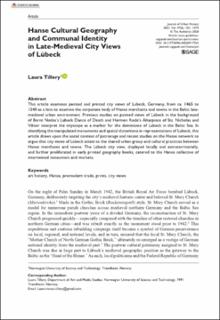Hanse Cultural Geography and Communal Identity in Late-Medieval City Views of Lübeck
| dc.contributor.author | Tillery, Laura | |
| dc.date.accessioned | 2021-11-15T13:34:22Z | |
| dc.date.available | 2021-11-15T13:34:22Z | |
| dc.date.created | 2021-03-19T12:57:50Z | |
| dc.date.issued | 2020 | |
| dc.identifier.citation | Journal of Urban History. 2020, 1-24. | en_US |
| dc.identifier.issn | 0096-1442 | |
| dc.identifier.uri | https://hdl.handle.net/11250/2829624 | |
| dc.description.abstract | This article examines painted and printed city views of Lübeck, Germany, from ca. 1465 to 1540 as a lens to examine the corporate body of Hanse merchants and towns in the Baltic late-medieval urban environment. Previous studies on painted views of Lübeck in the background of Bernt Notke’s Lübeck Dance of Death and Hermen Rode’s Altarpiece of Sts. Nicholas and Viktor interpret the cityscape as a marker for the dominance of Lübeck in the Baltic Sea. In identifying the manipulated monuments and spatial distortions in representations of Lübeck, this article draws upon the social context of patronage and recent studies on the Hanse network to argue that city views of Lübeck attest to the shared urban group and cultural practices between Hanse merchants and towns. The Lübeck city view, displayed locally and extraterritorially, and further proliferated in early printed geography books, catered to the Hanse collective of intertwined consumers and markets. | en_US |
| dc.language.iso | eng | en_US |
| dc.publisher | Sage Publications | en_US |
| dc.title | Hanse Cultural Geography and Communal Identity in Late-Medieval City Views of Lübeck | en_US |
| dc.type | Peer reviewed | en_US |
| dc.type | Journal article | en_US |
| dc.description.version | publishedVersion | en_US |
| dc.source.pagenumber | 1251-1274 | en_US |
| dc.source.volume | 47 | en_US |
| dc.source.journal | Journal of Urban History | en_US |
| dc.source.issue | 6 | en_US |
| dc.identifier.doi | 10.1177/0096144220917933 | |
| dc.identifier.cristin | 1899304 | |
| dc.description.localcode | © The Author(s) 2020 | en_US |
| cristin.ispublished | true | |
| cristin.fulltext | original | |
| cristin.qualitycode | 1 |
